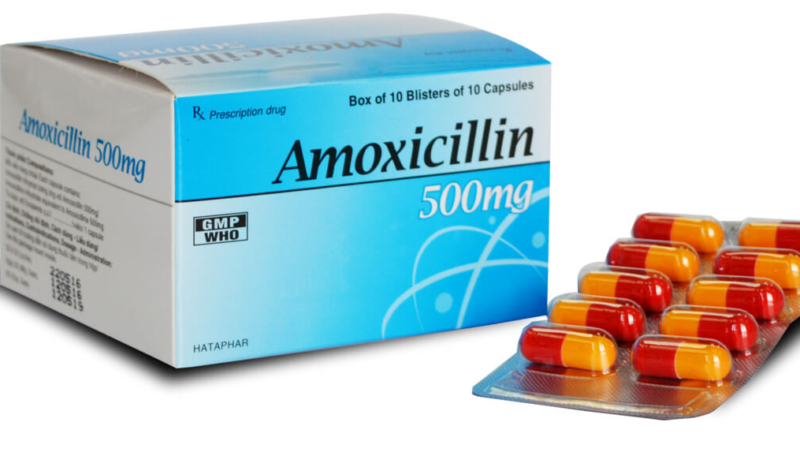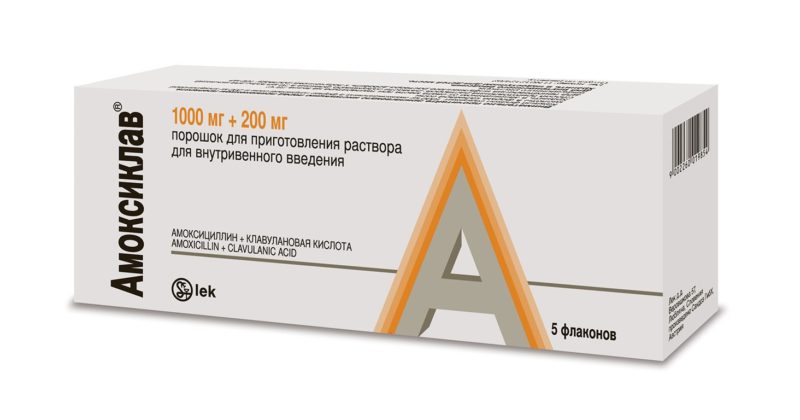Amoxicillin + clavulanic acid is a highly active antibiotic drug with a combined effect, designed to treat a wide range of infectious and inflammatory pathologies and purulent processes in various tissues and organs. It is characterized by increased efficiency and a rather low frequency of adverse adverse reactions. It can be used in children from the first days of life.
Material Content:
- 1 Forms of release and composition of the drug
- 2 Pharmacological properties
- 3 What diseases are prescribed antibiotic
- 4 Instructions for use and dosage
- 5 During pregnancy and lactation
- 6 Amoxicillin + Clavulanic Acid Compatibility with Alcohol
- 7 Drug interaction
- 8 Contraindications, side effects and overdose
- 9 Analogues of a combined antibiotic
Forms of release and composition of the drug
The treating basis of a medication consists of two essential components:
- the antibiotic amoxicillin from the penicillin class (in the form of a Na salt);
- clavulanic acid (in the potassium salt compound).
The medicine is made in three treatment forms:
- powder for solution for injection and intravenous infusion, packaged in glass vials with two dose options for antibiotic and clavulanate: 1000 + 200 mg, 500 + 100 mg;
- Amoxicillin + clavulanic acid tablets, protected by a soluble shell with antibiotic dose options of 500, 875, 250 mg and the same amount of acid - 125 mg;
- powder for suspension for young patients with a berry aroma, in plastic bottles with an attached measuring cap.Available in 2 versions: 5 ml of the finished drug emulsion may contain 125 mg of antibiotic plus 31.25 mg of potassium clavulanate or 250 + 62.5 mg.
Inactive ingredients included in the composition - formative, emulsifying and preserving substances.
The brand name of the drug may be different, since many similar dosage forms have been developed that use a combination of these substances in different dosages. In some analogues, the manufacturer adds ampoules of water for injection to bottles with powder for injections.
Pharmacological properties
The drug exhibits its therapeutic properties due to the characteristics and interaction of its two active substances.
Their combination gives a unique therapeutic effect: an antibiotic destroys a wide range of pathogens, showing a pronounced bactericidal effect. Clavulanic acid suppresses beta-lactamases (types 2–5) - special enzymes secreted by pathogenic bacteria and increasing their resistance to amoxicillin. The acid prevents the breakdown of the antibiotic by the penicillinase enzyme by binding to it in a stable complex.
In addition, clavulanic acid also demonstrates its own antimicrobial activity, activates antibacterial immunity.
Amoxicillin is able to cope with many types of aerobic and anaerobic bacteria (including those that produce beta-lactam enzymes). Among them: staphylococcal and streptococcal flora, enterococci, peptococci and peptostreptococci, bacteroids, yersinia, listeria, clostridia, neisseria, intestinal and hemophilic bacilli, protea, klebsiella, bordetella, salmonella, shigella, moberobella, gardella mackerelby, mardobella, gardebella, mardobella, gardellae Capnocytophaga, a bacillus from the NASEC group of Eikenella corrodens, fusobacteria, porphyromonads, Prevotella, bacteria of the genus Leptospira, Borrelia, pale treponema.
Both components are actively absorbed and distributed, penetrating into the lungs, bronchi, uterus, liver, tissues of the ENT organs, gall bladder, sex glands, synovial, peritoneal, pleural fluid, prostate, muscle tissue, and bones.
In the absence of an inflammatory focus in the meninges, therapeutic substances are not found in cerebral tissues, but they penetrate into the blood of the embryo and breast milk in small quantities.
About a tenth of the amount of amoxicillin received in the body and almost half of clavulanic acid undergo enzymatic processing in the liver.
Both substances are excreted together with urine: up to 78% of the received dose of the antibiotic and up to 40% of clavulanic acid. Partially can be removed from the body through the intestines and during breathing.
What diseases are prescribed antibiotic
The combined antibacterial drug is intended to suppress infections that cause inflammatory processes that provoke the activity of bacterial pathogens that are sensitive to the drug.
The main diseases in which the medication helps:
- inflammation of the inner lining of the heart (endocarditis), meningitis, peritonitis, pelvic peritonitis;
- acute and long-term inflammatory processes of the throat, nose, ear (purulent tonsillitis, inflammation of the airways, sinus, middle ear, fiber and lymph nodes - retropharyngeal abscess);
- bronchitis, inflammation and abscess of the lungs, pleural empyema;
- bacterial vulvovaginitis, endometritis, inflammation of the appendages, fallopian tubes, prostate, urethra and cervix, cystitis, pyelonephritis;
- sexually transmitted diseases - chancroid, gonorrhea;
- inflammatory diseases and suppurations of the skin and tissues: abscess, erysipelas, leptospirosis, dermatoses with secondary infection, impetigo, carbuncle, phlegmon, purulent wounds;
- osteomyelitis and other purulent and inflammatory processes of bones and joints;
- salmonellosis, cholecystitis, borreliosis, enterocolitis;
- postoperative and mixed infections (blood poisoning, septic abortion);
- periodontitis, inflammation of the nasal mucosa due to dental manipulations (odontogenic, maxillary sinusitis), dentoalveolar abscess (flux);
- prevention of infection during operations.
If it is difficult to diagnose a long-term current disease, during the treatment it is necessary to take body fluids (urine, blood, sputum, smears) and analyze microbiological samples to identify the pathogen and its reaction to the medication. If necessary, adjust the therapy, change the dosage or replace the antibiotic.
Instructions for use and dosage
Doses and frequency of medication are determined by the doctor, taking into account the severity and type of pathology, age, contraindications and concomitant diseases.
It should be borne in mind that the recommended dosages of a medicine manufactured by different manufacturers may vary.
Features:
- The use of pharmaceuticals in the form of a suspension is recommended for patients younger than 12 years old and older patients with swallowing problems.
- Inside, it is advisable to take the medicine at the beginning of food intake in order to minimize the risk of possible unwanted effects from the stomach and intestines.
- An injection solution is not allowed to be administered intramuscularly (only intravenously). For infants up to 12 weeks of age, an antibiotic solution is infused only through a dropper, infusion.
- Accurate dosing for young patients younger than 10-12 years old (or weighing less than 40 kg) is carried out by calculating based on the patient’s body weight.
The standard treatment regimen for different forms of antibiotic is shown in the table.
| Age group | Doses in terms of amoxicillin | ||
|---|---|---|---|
| Suspension for children | Intravenous injection | Pills | |
| Newborns and infants up to 3 months | The dose per day, calculated at the rate of 20-30 mg per 1 kg of infant weight, is divided into 2 doses | premature babies and infants up to 5 weeks of life or weighing up to 4 kg - daily amount of 25-30 mg per kilogram of weight 2 times (after 12 hours), from 5 weeks or weighing more than 4 kg - 3 times after 8 hours | Do not use |
| Maximum | The greatest amount per day is limited by the norm of 30 mg per 1 kg of weight | ||
| 3 months to 12 years | 25 mg / kg per day for 2 times. Or 20 mg / kg per day, divided into 3 doses. In severe cases, 40–45 mg / kg per day in 3 or 2 doses (respectively) | The daily amount is 25 mg per kilogram of the weight of the child. Divided into 3 injections. In severe cases, injections are made 4 times after 6 hours | Do not use |
| Maximum | The largest amount per day - 45 mg per 1 kg of weight | ||
| Adults and patients from 12 years old or weighing 40 kg or more | similar to tablet doses | 1000–1200 mg is injected into a vein 3 or 4 times a day, taking into account the severity of the process | 2 times 500 mg or 3 times 250 mg, in severe cases - 2 times 875 or 3 times 500 mg in 24 hours |
| Maximum | 6000 mg per day |
The duration of therapy is set by the attending specialist, the standard duration is at least 5, maximum 14 days.
Long-term drug intake into the body can lead to the development of resistance of microbes to pharmaceuticals and to their excessive reproduction.
If, after 3 days after the start of the application, the patient has no improvement, the specialist adjusts the treatment or transfers the patient to another medication.
To prevent "hospital infections" after surgery for up to 60 minutes, 1000 mg (for adults) is administered intravenously during anesthesia. For longer operations, an infusion is made every 6 hours throughout the day, prolonging the course against the background of an increased risk of infection up to 2-6 days.
With chronically impaired renal function, the dose and frequency of antibiotic use are reduced in accordance with the degree of insufficiency and creatinine clearance (CC).If the patient undergoes hemodialysis, in which most of the treatment substances are removed from the blood, the dose of the drug at the end or during the procedure is not required to be reduced.
Amoxicillin + clavulanic acid is administered intravenously for at least 3-4 minutes. To make an intravenous injection with a syringe, injection water is added to the powder, strictly observing the proportions between the amount of powder and the volume of solvent indicated in the medical instructions. With a drip-infusion infusion, the antibiotic solution already obtained is additionally diluted with a solution of NaCl, KCL, Ringer.
Suspension Amoxicillin + clavulanic acid is prepared only by diluting the powder with boiled water.
During pregnancy and lactation
It has been established that pharmacological substances enter the fetal bloodstream, but do not lead to the development of congenital malformations and do not worsen the course of pregnancy. But, despite the relative safety of the medicine, in order to exclude unpredictable consequences for the health of the baby, the medication is prescribed for the expectant mother in the absence of other, safer antimicrobial agents. And also with obvious benefits for the patient in comparison with the likelihood of harm to the fetus.
Small amounts of healing components are found in breast milk, which can sometimes cause an infant to have oral thrush or loose stools. No other adverse effects on the health of infants have been identified. Therefore, the medication can be prescribed to a nursing patient, but it is advisable to transfer the child to feeding with milk mixtures (in whole or in part) during treatment.
Amoxicillin + Clavulanic Acid Compatibility with Alcohol
The combination of ethanol with a pharmaceutical enhances the toxic effect of alcohol on the liver, leading to its defeat or worsening the condition of the organ with existing pathologies.
The likelihood of dangerous effects from the nervous system from the effects of the drug also increases, as well as the severity of these negative effects. May occur: nausea, vomiting, loss of orientation, panic attack, cramps, a sharp drop in pressure up to loss of consciousness and coma.
In addition, the substances formed during the decay of ethanol significantly weaken the therapeutic effect of the antibiotic, making it useless.
Drug interaction
The drug is pharmaceutically incompatible and does not allow mixing:
- with intravenous pharmaceutical products containing proteins, blood, emulsified lipids;
- with dextrans, glucose solution, NaHCO3;
The simultaneous appointment of:
- with digoxin, disulfiram;
- with medicines such as Probenecid, Phenylbutazone, Allopurinol (acute skin reactions, exanthema), Methotrexate (increased toxicity), mycophenolate mofetil (a significant decrease in the therapeutic effect);
- with diuretics and non-hormonal anti-inflammatory drugs (increased severity and frequency of adverse reactions);
- with antibiotics from the group of macrolides, lincosamides, tetracyclines, with sulfonamides and chloramphenicol (mutual weakening of the therapeutic effect).
In addition, the simultaneous administration of a medication with Warfarin, Acenocoumarin can lead to an increase in the flowing properties of the blood, and the risk of hemorrhage.
Women should also consider that Amoxicillin reduces the effectiveness of birth control pills, and when taken with Ethinyl Estradiol in parallel, there is a risk of breakthrough bleeding.
Also, intravenous administration in one syringe or mixing in an infusion bottle with aminoglycoside antibiotics is not allowed (weakening of the therapeutic effect).
Contraindications, side effects and overdose
An antibiotic drug is not allowed to be prescribed in the presence of such inhibiting factors as:
- intolerance to any components of the medication, as well as other β-lactam antibiotics, including penicillins, cephalosporins, carbapenems, monobactams;
- infectious mononucleosis (including the manifestation of a rash);
- age up to 12 or body weight up to 40 kg - for tablets;
- episodes of severe allergic reactions to any medication, especially antibiotics;
- transferred jaundice, disorder of the liver after a previously used combination of amoxicillin with potassium clavulanate;
- pseudomembranous colitis diagnosed after the use of penicillins.
Under constant supervision and with the possibility of reducing the dose, the medication is prescribed for pregnant and lactating patients, people with severe liver and kidney failure, and diseases of the gastrointestinal tract.
In general, the antibiotic is tolerated by patients quite satisfactorily, since it is characterized by the low toxicity characteristic of penicillins.
Undesirable side effects that may occur in a patient:
- candidiasis (fungal infection) of the skin and mucous membranes, including thrush in the oral cavity in infants;
- loss of appetite, nausea, vomiting, loose stools;
- itching, rash, red spots on the skin;
- dizziness, transient arousal, especially in children;
- reversible increase in the fluid properties of blood (prothrombin time), temporary anemia, a decrease in the number of leukocytes;
- sometimes - inflammation of the venous wall at the site of an intravenous injection.
In some cases, especially with the long-term use of high doses, there are:
- impaired renal function (including interstitial nephritis, crystalluria), liver (temporary increase in ALT or ACT);
- erythema multiforme exudative, exfoliative dermatitis;
- swelling of the eyelids, lips, tongue, larynx (Quincke), anaphylactic shock;
- jaundice due to stagnation of bile, inflammation of the liver tissue, pseudomembranous colitis.
In case of any adverse reactions that acquire alarming signs and a pronounced course (prolonged diarrhea, acute swelling of the larynx, eyelids, tongue, shortness of breath, cramps, especially in children), the medication should be immediately stopped and the ambulance called.
Signs of an overdose can be expressed in the appearance of previously not observed side effects or in a sharp increase in existing ones. Most often, this is vomiting against a background of abdominal pain, loose stools, overexcitation, sleep disorder, convulsive attacks and an acute allergic reaction.
Treatment involves the appointment of drugs that eliminate negative symptoms, in severe cases - the use of hemodialysis.
Analogues of a combined antibiotic
The most famous antibiotic analogues containing identical active substances:
- Amoxiclav, Medoclav in tablets, protected by a coating, soluble forms, powder for suspension and preparation of an intravenous solution;
- Flemoklav Solutab in the form of dispersible tablets;
- Augmentin SR in the form of an already prepared suspension, film-coated tablets, in powder for injection;
- Ecoclave in tablets and powder for suspension;
- Rapiclav, Panclave, Hemofarm tablets.
Pharmaceutical products are produced by various pharmaceutical companies in various dosage forms and dosages, which should be considered when choosing a drug.


















